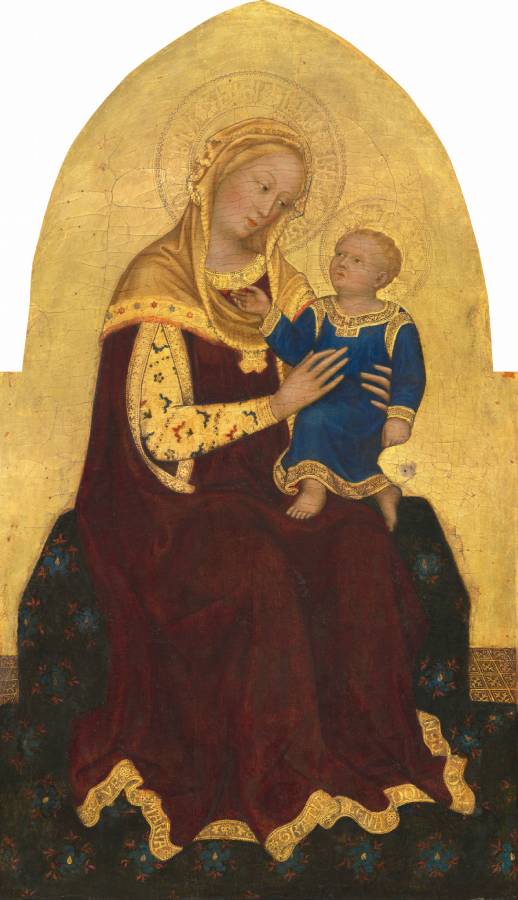Gentile da Fabriano (c.1370-1427)
Madonna col Bambino in trono (Madonna and Child Enthroned)
c.1420
Tempera on poplar panel, 95.7 x 56.5 cm
National Gallery of Art, Washington
A young woman, holding a baby in her lap, sits on a wide bench draped with a patterned midnight-blue fabric in this vertical panel painting. The panel is rectangular at the bottom and becomes a pointed arch at the top. The woman and baby both have pale skin tinged with peach, and halos inscribed on a gleaming gold background. The woman’s body is angled to our right and she tilts her head in that direction to look down at the child. She has a slender, oval face, with hazel-brown eyes under thin brows, a long nose, and coral-pink lips. A sliver of blond hair peeks out from the honey-gold cowl that covers her head, neck, and shoulders. The cowl is layered over her gold-trimmed, burgundy-red robe, which has an opening through which her right arm, closer to us, reaches to support to the child. That arm is covered by a long, gold sleeve patterned with scalloped brick-red and marine-blue designs and smoke-gray flowers. The word “MATER” is inscribed on her neckline and “AVE MARIA GRATIA PLENA DOM TECV BEN” along the bottom hem. On the woman’s lap, the child is angled to our left with the woman’s slender hands wrapped around his torso. His mouth is slightly open as he tilts his head up to look at her. His right hand, on our left, reaches up to gesture at her neckline. He has wavy, blond hair and hazel eyes under faint brows, a small nose, and peach-colored lips set in a round face. He wears an ankle-length, cobalt-blue tunic trimmed with bright gold. The fabric on the bench is covered with cobalt-blue and crimson-red flowers, and pools around the seat and across the floor.
Gentile da Fabriano‘s patrons were princes, the church, and various city governments as well as the customary merchant clients. His art has a cosmopolitan flavor, in which brilliant color, textural richness, and ornamental pattern are combined.
In the Madonna and Child Enthroned, painted in Florence, Mary sits on a bench covered by floral material that falls onto an elaborately tiled floor. The elegantly attired figures are surrounded by four angels, barely visible, which have been incised into the gold-leaf background. In contrast to earlier devotional images in which the Madonna and Child appear as a celestial vision, the holy figures here appear very corporeal. As if to emphasize Mary’s role as Divine Mother, the Christ Child gestures with his right hand toward the Latin word Mater inscribed on the collar of her mantle. The string in his other hand tethers a butterfly, a traditional symbol of Christ’s resurrection from the tomb.
Gentile‘s art is typical of the International Style, a manner of painting which became popular at courts throughout Europe in the late fourteenth and early fifteenth centuries. Characterized by a refined decorative elegance, a concern for continuous rhythms, and the lavish use of gold and bright colors, this aristocratic manner fused the stylized art of the Middle Ages with the emerging naturalistic interests of the Renaissance. (NGA)

